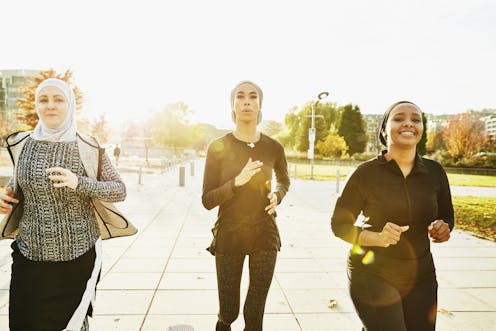Why Muslim women choose to wear headscarves while participating in sports
- Written by Umer Hussain, Postdoctoral research associate, ADVANCE, Texas A&M University

The French Senate[1] recently voted in favor of a bill to ban headscarves in sports competitions. The advocates of the legislation claim that headscarves, or hijab, symbolize[2] Islamic radicalism, patriarchy and lack of women’s empowerment.
Muslim women athletes and women’s rights activists have condemned[3] the proposed law, with one commentator calling it “gendered Islamophobia[4].” Others have pointed out how such laws[5] have the potential to limit Muslim women’s inclusion in sports.
As researchers who study[6] diversity inclusion[7] in sports, we conducted several studies focusing on sports participation among Muslim women over a period of three years. Our recent study[8], published in 2021, shows that many Muslim women want to wear a hijab while participating in sports, and they list many reasons for doing so.
Muslim women and sports
Muslim women’s participation in sports has historically remained lower[9] than in many other marginalized groups, such as Indigenous groups and other racial minorities. This is especially evident in socially conservative countries[10] such as Saudi Arabia[11] and Pakistan[12], where only a few women have ever participated in the Summer Olympics.
In recent years, however, more Muslim women have started to participate in sports, especially in Western countries[13]. In general, there has been a boom in the sale of modest Islamic fashion wear[14] and hijab as fashion accessories.
In 2018, the global Muslim fashion wear market was estimated to be US$283 billion[15], with Turkey, United Arab Emirates and Indonesia being the biggest ones. This market is expected to grow to $402 billion[16] by 2024.
Various sports brands have introduced hijab for sports to tap into this market. For instance, Nike[17] introduced a “Pro Hijab” in 2017. Several other companies[18], such as Ahida, LiaWear and Asiya Sport, were producing hijab for sports before Nike.
We wanted to explore what Muslim women were saying about wearing a hijab during their participation in sports.
What research shows
We employed a three-study[19] approach to collect data. This meant that we collected data through open-ended questions from 23 Muslim women living in the United States in the first study. Based on these results, we developed an online survey questionnaire and conducted a preliminary test with 282 women from 11 countries. We further revised our materials and conducted the final study with a sample of 347 Muslim women from 34 countries.
Women in our study were wearing hijab already, so we asked them why they wanted to wear the hijab during sports. Among reasons they listed were that the hijab allows them to adhere to their religious beliefs, is comfortable and makes them feel empowered. One of the participants stated: “The idea of a hijab is tied with the concept of freedom and human rights. To me, a hijab is a personal belief and ideology, and everyone has the right to follow it or not.”
The influence of other people in their lives was also a big factor. For instance, several participants reported that men or women in their families could influence their choice of wearing a hijab.
We also found that the views of other Muslim women were often influential in their decisions. For example, women were enthusiastic about purchasing the sportswear when their friends had also done so.
However, some Muslim women expressed the fear of being harassed in Western countries when they wore a hijab in sports. For example, one participant reported: “Sometimes other community members do not accept a pro-sport hijab and treat the woman with a hijab differently. That can bring some negative feelings to that woman, like fear of being judged and mistreated in society.”
We argue[20] that this fear of harassment as a result of wearing a hijab in sports within Western countries could be a major barrier in enhancing Muslim women’s sports participation.
Other scholars[21] have previously found that for Muslim women, wearing a hijab during sporting activities can be empowering. Researchers[22] have also argued that Muslim women consider the hijab to be part of their unique identity[23] in various Western contexts. It should be noted that not all Muslim women wear the hijab.
Scholars have previously also reported that Muslim women’s modest sportswear purchasing behavior is dependent upon social norms[24] and cultural values[25]. For instance, the hijab has historically not been worn in the Indian subcontinent. Therefore, many Muslim women from Pakistan and India participate in sports without wearing hijab[26].
Advocates for banning or opposing hijab in France should listen to the views of Muslim women who want to wear a hijab in sports. If the voices of the hijabi are not heard, then it will further exclude Muslim women from sports participation.
[Get fascinating science, health and technology news. Sign up for The Conversation’s weekly science newsletter[27].]
References
- ^ French Senate (apnews.com)
- ^ symbolize (www.cnn.com)
- ^ condemned (www.france24.com)
- ^ gendered Islamophobia (www.cbc.ca)
- ^ Others have pointed out how such laws (www.cnn.com)
- ^ study (hlkn.tamu.edu)
- ^ diversity inclusion (directory.education.tamu.edu)
- ^ study (doi.org)
- ^ historically remained lower (doi.org)
- ^ socially conservative countries (oaktrust.library.tamu.edu)
- ^ Saudi Arabia (oaktrust.library.tamu.edu)
- ^ Pakistan (oaktrust.library.tamu.edu)
- ^ Western countries (doi.org)
- ^ modest Islamic fashion wear (theconversation.com)
- ^ US$283 billion (cdn.salaamgateway.com)
- ^ $402 billion (cdn.salaamgateway.com)
- ^ Nike (www.usatoday.com)
- ^ other companies (www.raqtive.com)
- ^ three-study (doi.org)
- ^ argue (doi.org)
- ^ Other scholars (www.routledge.com)
- ^ Researchers (www.routledge.com)
- ^ unique identity (oaktrust.library.tamu.edu)
- ^ social norms (doi.org)
- ^ cultural values (doi.org)
- ^ without wearing hijab (oaktrust.library.tamu.edu)
- ^ Sign up for The Conversation’s weekly science newsletter (memberservices.theconversation.com)
Authors: Umer Hussain, Postdoctoral research associate, ADVANCE, Texas A&M University

